I’m not going to leave you hanging: here is the most popular way to avoid burning and sticking when boiling milk:
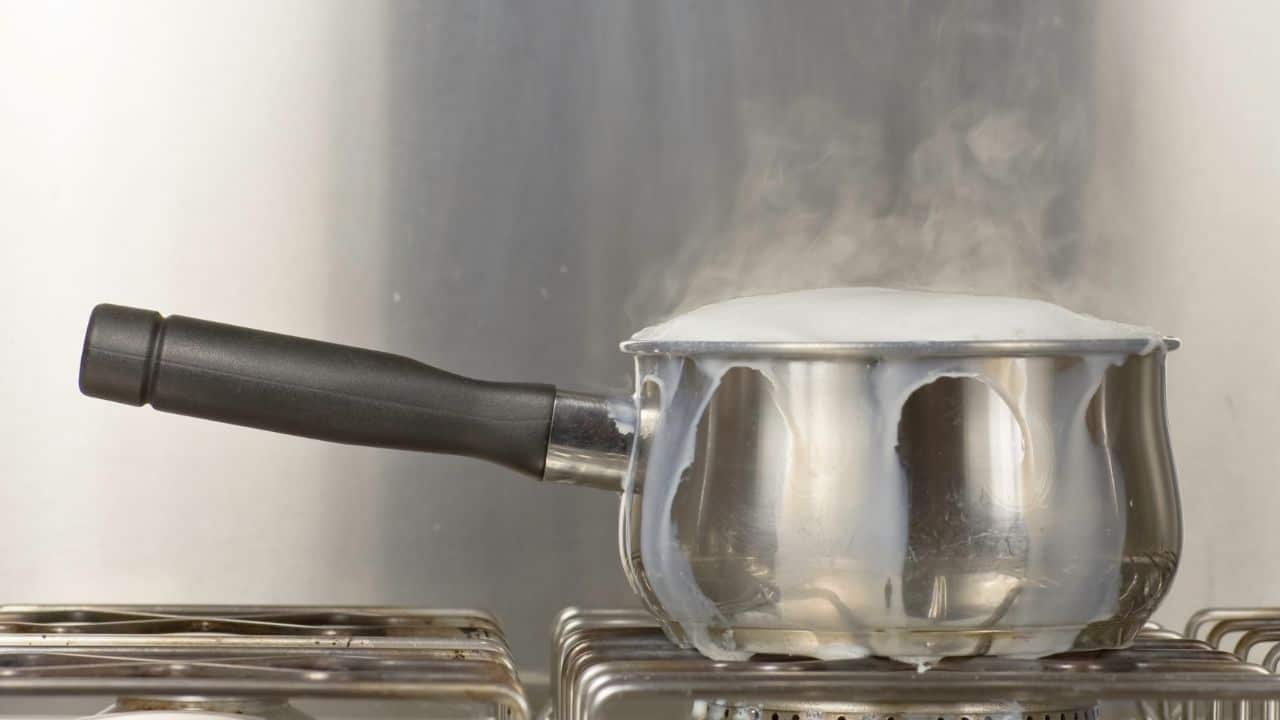
- Take a small food-grade stainless steel pot.
- Using a tissue slightly covered with cooking oil or butter, grease the inside of your pot or saucepan.
- Add a dash of water (there should be about 1 tbsp of cold water left in the pot, as that’s your anti-burning protective layer).
- Pour your milk into the pot and bring it to a boil on low heat.
- Once the milk starts to boil, remove it from heat – and voila, no mess to scrub!
- Now you can clean the pot just by rinsing it under running water.
Check out the video below to see how to do it exactly and what sort of results you can expect using this simple milk-boiling hack.
Easy! This could have been my shortest tutorial yet – however, the milk whispering procedure as such isn’t why I started this conversation. Rather, I would like to discuss in detail why I prefer doing it this way – and why it’s crucially important for your health and well-being!
Intrigued? Let’s talk this through, but it’s kind of a long story – so make yourself a relaxing cup of hot chocolate and get comfortable, as we have a lot to discuss.
It’s quite easy to get milk sticking to the bottom of the saucepan when boiling it. It forms a sticky layer of burnt milk, and it’s difficult to clean. Here are some very effective and a bit less effective ways to boil milk without burning or sticking.
My Quest For Boiled Milk
White jelly. Creamy potatoes. Custard. Babycino.
…and hundreds of other dishes and snacks requiring boiled milk! As an avid cooker, it seems like not a single day goes by in my household without the need to boil a pot of milk.
Between juggling other household responsibilities and entertaining toddlers, it’s easy to miss the precious second when the milk is just right – and before you know it, everything is sticky and burnt. Oh, the pain!
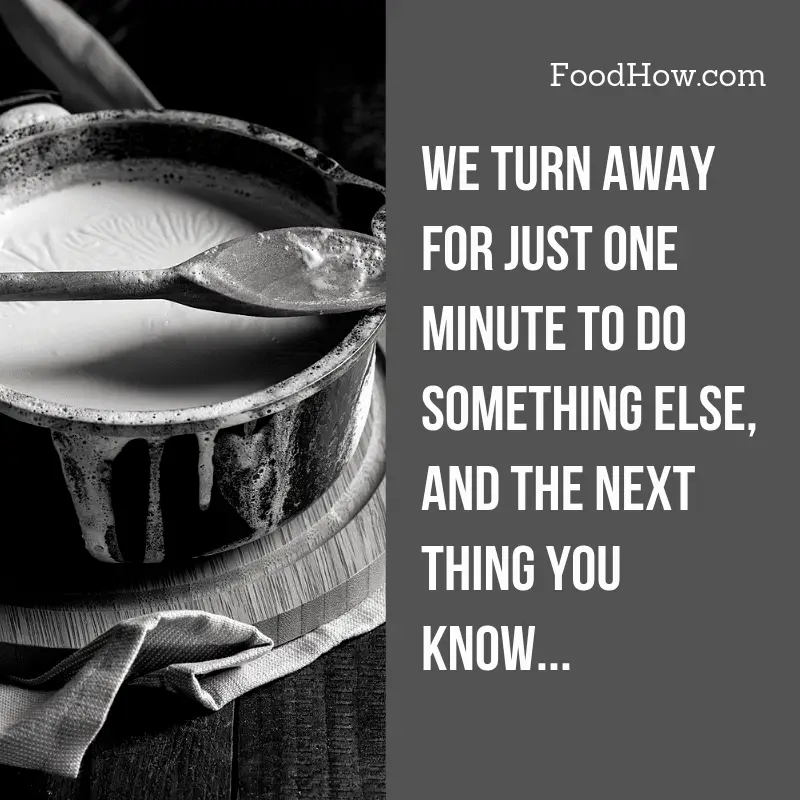
Unsurprisingly, I’ve been on a quest for a perfect method for boiling milk for a long while and finally found it.
But some of the other things I’ve discovered along the way were troubling, to say the least. Today I would like to share some of my findings with you. So hopefully, you can avoid the alarming mistakes I’ve been unknowingly making for a good chunk of my life…
The Truth About Toxic Cookware
If you search online for painless milk boiling tips, one of the major ones you’re likely to find is using non-stick cookware. Some of the options commonly listed include Teflon, aluminum, copper, and ceramic-coated pots and saucepans.

However, I’m not the one to stop digging on the first search engine results page, so I kept reading on and discovered that all these options have something not-so-great in common: they are, in fact, a bit toxic!
The disadvantages of using these are so prominent that I would never recommend trading your health for a slightly easier milk-boiling process, especially since there are much safer methods.
Not to sound dramatic, but even the best dietary choices can produce terrible health complications if toxic cookware is used routinely! And if you are still skeptical (just as I was at the start of my quest), below, you will find more information about the worst offenders.
Teflon
I personally consider this trendy guy the worst offender!
For most people, the primary reason for choosing Teflon is convenience – yet, little do they know about the harm involved. This is because to make Teflon pots non-stick, they are generously coated with something called PTFE (or if you’re feeling chemically inclined today, polytetrafluoroethylene).
This plastic polymer releases toxic fumes when heated, causing symptoms such as headaches, chest tightness, and more. The symptoms typically appear a few hours post-exposure, so it’s not that easy to connect the dots. And if you have pet birds, please eliminate Teflon since the fumes can be deadly for feathered creatures!
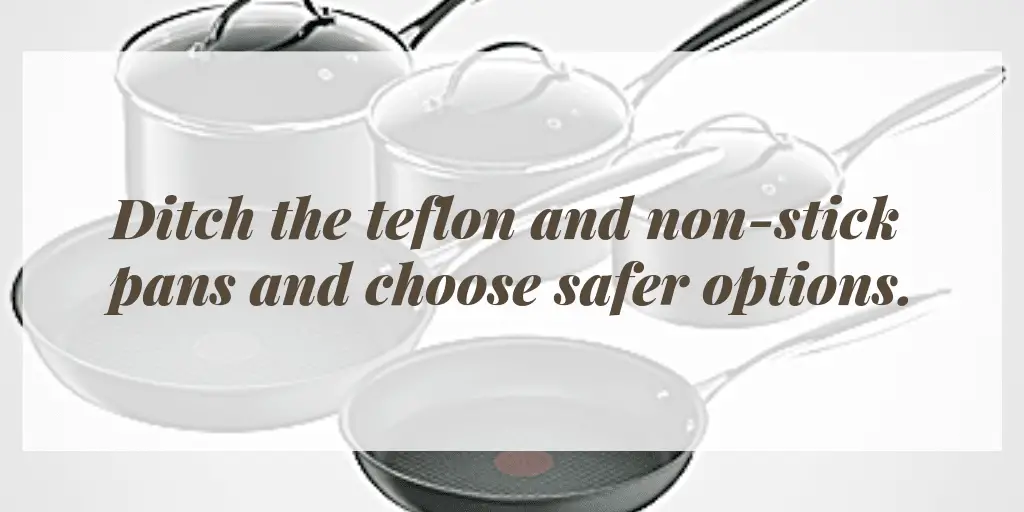
But wait, there’s more: Teflon cookware also contains PFOA (stands for perfluorooctanoic acid), also known as C8. This chemical can stay in the body and in the environment for prolonged periods, which is scientifically linked to several types of ailments.
Although the C8 content of Teflon cookware is deemed relatively low, it adds up to our total daily exposure along with other products, and it makes sense to try and limit the negative effects, at least when cooking.
If you still insist on using Teflon, then to minimize the risk, you should always treat it with the utmost care, not heating the pan or pot excessively or leaving it unattended.
Make sure you are always heating the saucepan with something in it and never scratch off the Teflon and consume it for dinner.
If you are only using your Teflon saucepan to warm your milk, then you should be quite safe, but keep on reading as I still have some different options for you below.
Granite Coating
As more and more consumers discover the dangers of Teflon, there is a high interest in non-stick alternatives, such as granite coating. And it can be safe…but only if it’s completely intact, which is not the most realistic expectation for something heavily used daily.
As soon as the stone-coated item starts chipping, discard it immediately, and don’t let toxic substances literally slip through the cracks.
Aluminum
Affordable, lightweight, and widespread – it’s no surprise that aluminum cookware is insanely popular, especially among frugal housewives. However, the cost of the next hospital bill may very well offset the temporary savings…
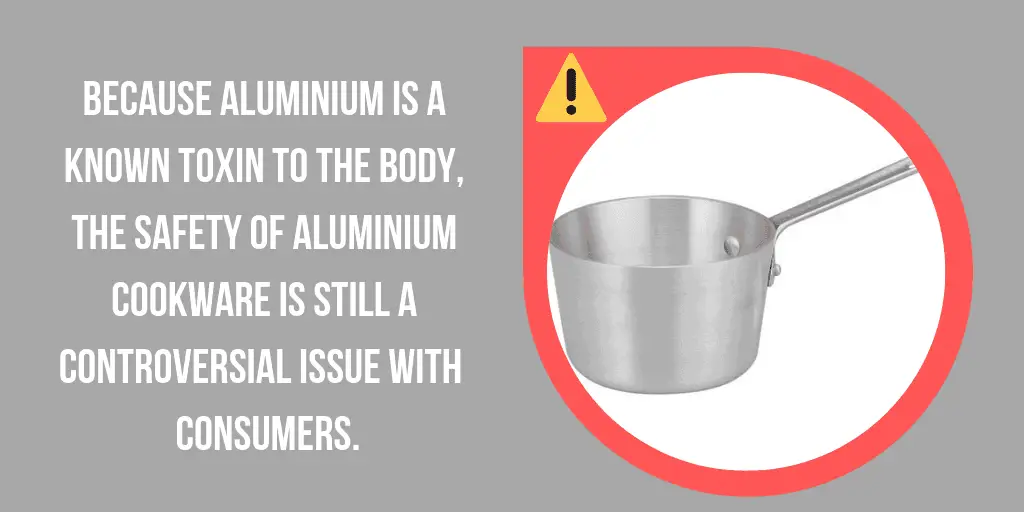
See, aluminum acts as a neurotoxin, damaging the brain and disrupting neural transmission! Elevated aluminum levels in the body have been linked to conditions such as Alzheimer’s and ALS, for instance.
You might object and say that aluminum cookware is coated – however, just like stone coating, this protective layer is incredibly easy to damage! Besides, tiny invisible chips may end up on your plate, promoting aluminum ingestion. Certainly not ideal!
Copper
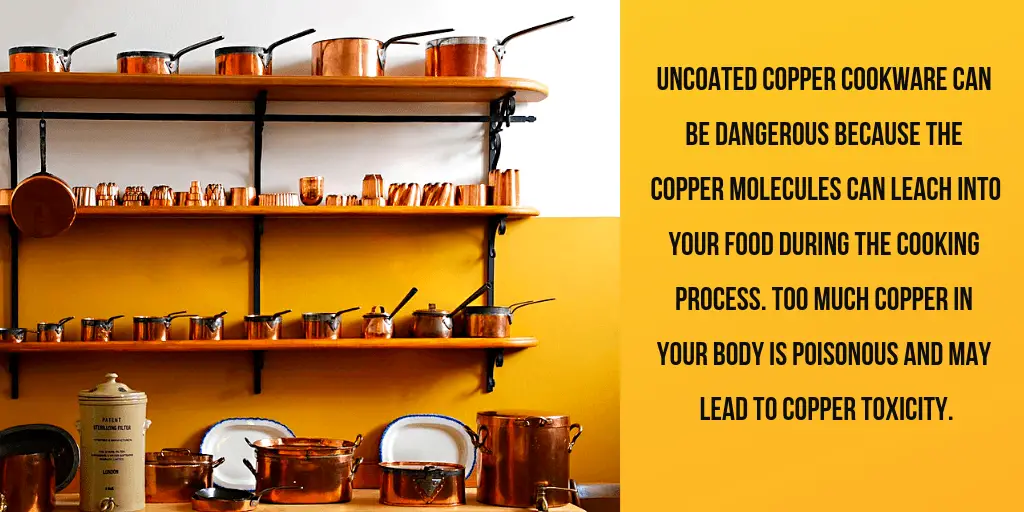
Copper cookware is on-trend with its stylish looks and sturdy properties! However, I strongly advise against adding copper items to your cookware collection.
Copper cookware can cause excessive copper ingestion, sending you right to the ER with some scary symptoms! These may include vomiting, yellowy skin, dizziness, and gastrointestinal discomfort, and any combination warrants prompt medical attention.
Soft Ceramic-Coated Cookware
It looks nice and appears safe – after all, you might have seen claims deeming ceramic 100% safe for cooking! Unfortunately, the ceramic coating wears off, revealing the nasty stuff beneath.
Worst of all, the soft ceramic coating is very soft, so damaging it doesn’t require any effort, just a few months of constant gentle use.
The coating chips often contain lead and cadmium, and both can cause severe poisoning in extreme cases. Otherwise, you may experience consequences such as gastrointestinal discomfort, vomiting, infertility, and more.
Feeling a bit overwhelmed?
I was too upon just discovering the information above and doing more research to confirm these findings. Fortunately, however, there are safe alternatives to use – so in the next section, where I’ll tell you all about it!
Are your pots and pans #toxic? There could be some hidden chemicals in your #cookware, but don’t worry; here are 3 safe alternatives you can use instead.
The Best Non-Toxic Cookware Options

Protect your family from cookware toxicity by using one of the safer options below! All the options listed are my tried-and-true favorites that have stood the test of time (not to mention how easy they make milk boil).
Currently, in my kitchen, you will find the following types:
Cast Iron
Great pot for simmering soups, boiling milk, or making sauces.
Some 100 years ago, cast iron was a true kitchen staple. This old-school favorite is made of, as you can expect, cast iron, which gives it amazing properties such as:
- Rapid heating (so you can cook on a lower heat setting, naturally preventing sticking).
- High-temperature resistance – suitable for oven cooking.
- It doesn’t contain any nasty chemicals, just iron! It may end up in your food, which in this case, is a good thing, especially for those with confirmed iron deficiency. Conversely, if someone has a condition causing them to retain excess iron, pick one of the alternative non-toxic cookware options below instead.
All-Natural Quality Ceramic
This modern and cute ceramic non-stick and non-toxic milk pan is great for heating and frothing milk and ideal for making coffee, oatmeal, soups, scrambled eggs, etc. It is made from all-natural materials, and it does not contain PFOA/PTFE.
As mentioned above, the safety of some soft ceramic-coated cookware is questionable – however, using quality, all-natural, and full ceramic options eliminated the issues raised! On its own, ceramic:
- Is non-reactive.
- Transfers heat efficiently.
- Naturally non-stick.
- Generally lightweight.
- Requires little to no cooking oil for optimal results.
The main disadvantage is the relative fragility of 100% ceramic cookware. So, if you don’t want to worry about it too much, opt for other non-toxic alternatives, which are plentiful.
Glass
Not only non-toxic and eco-friendly, but glass cookware is also extremely durable – contrary to popular belief! Free of PFOAs or highly fluorinated chemicals, glass items are a great addition to your kitchen. Just in case, look for “oven-safe” labeling to avoid nasty surprises.
Bonus tip: storing your food in glass containers is also a far superior option compared to plastic counterparts!
This non-porous glass milk pan and pot above are absolutely perfect for boiling milk or many other tasks. This one is made out of glass, so it won’t absorb any food flavors or odors, and it won’t react with acid foods either; plus, it is a freezer, oven, microwave, and stove-top safe.
Premium Food-Grade Stainless Steel
Along with cast iron, premium food-grade stainless steel is crowned one of the best non-toxic cookware options.
This sturdy material resists damage, leaching, reactivity, and corrosion, making it ideal for food preparation.
However, buyers beware: there are many grades of stainless steel, and not all are food-safe.
This premium-grade, food-safe 18-10 stainless steel saucepan is also a great option for boiling and heating milk. It is 5 times cheaper than the glass one I mentioned above, and it has some great reviews.
When buying stainless steel cookware, look for the following grades for the ultimate peace of mind:
- 304
- 316
- 340
In addition, those sensitive to nickel should aim for 18/0 specification stainless steel (18% chromium, 0% nickel). Otherwise, small amounts of nickel may be present for additional corrosion and rust prevention. Learn more here.
To maintain the non-toxic properties, stainless steel cookware that has nickel lining should never be cleaned with abrasive materials. Otherwise, the damaged nickel lining may leach into your food, which is why any damaged stainless-steel cookware lined with nickel should be discarded immediately.
How To Prevent Milk From Burning And Sticking To The Pan
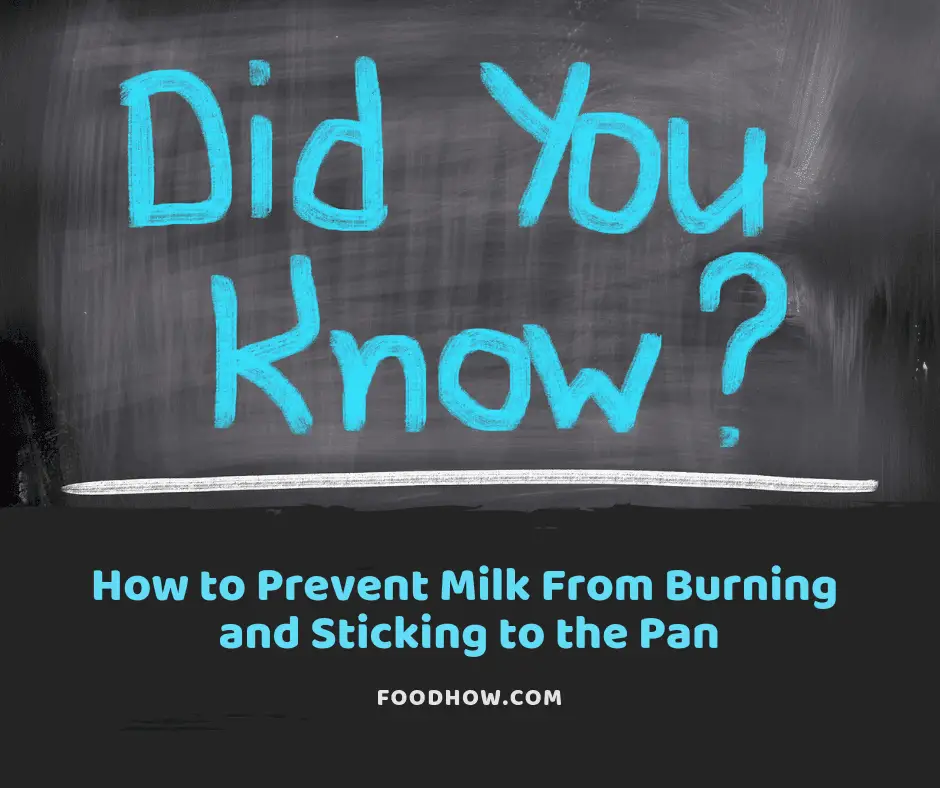
Now that we’ve identified the best non-toxic cookware let’s get right back to milk boiling!
In addition to the hybrid method that I covered at the beginning of the article, here are the most common methods of boiling milk without sticking, burning, or scorching.
1. Rinse The Saucepan With Water (somewhat effective)
This is the most popular way of boiling milk by coating cookware with cold water.
Although some of the other methods below are more effective when it comes to boiling milk without sticking, this one seems to be the most widely used.
- Rinse the inside of it with cold water and leave 1 tbsp of cold water in the pot, as that would act as an anti-burning protective layer.
- Pour milk into the saucepan and start heating it on low heat, stirring frequently.
- Keep stirring until the milk starts to boil.
2. Use An Oil Spray To Coat The Saucepan (very effective)
Try misting or creasing the pan with vegetable oil before boiling the milk. The science behind this method is quite fascinating: by making milk proteins less likely to adhere, vegetable oil prevents milk coagulation, the root cause of sticking nightmares.
I have made this video for a quick illustration of how to do it and the result you will get. Check it out here on YouTube.
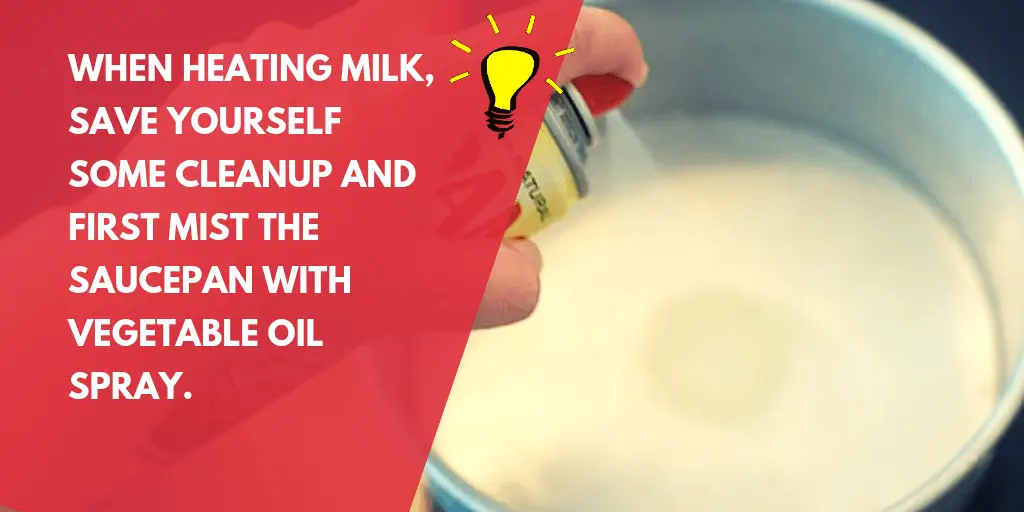
3. Use Boil Alert/Pot Watcher To Boil Milk Safely Without Burning
Another tip is to use the Boil Alert, also known as the Pot Watcher.
This little milk-boiling gadget starts rattling gently when the water or milk comes to a boil, as well as controls air bubble release to prevent boiling over. Catch the boiling point right on time – and your milk won’t stick!
I have not used the Boil Alert, Pot Watcher myself, and I have heard mixed reviews about it. If you have used Boil Alert Pot Watcher, then let us know about your experience with it in the comments below the post.
4. Try the Double Boiler Method (most effective)
As you probably know, the best way to melt chocolate without burning it is to use a double boiler method.
Now, double boilers can also help boil milk without burning or sticking. I find it one of the most effective options.
You don’t even need to splurge on a commercially available one – all you need is a deep and wide pan, as well as a large glass/metal bowl that fits it neatly.
The even heat distribution produced by the double-boiled prevents uneven coagulation of milk proteins, ensuring perfect results.
There are some really sophisticated-looking double boilers, but some of them look like regular saucepans.
5. Steam Your Milk With An Espresso Machine
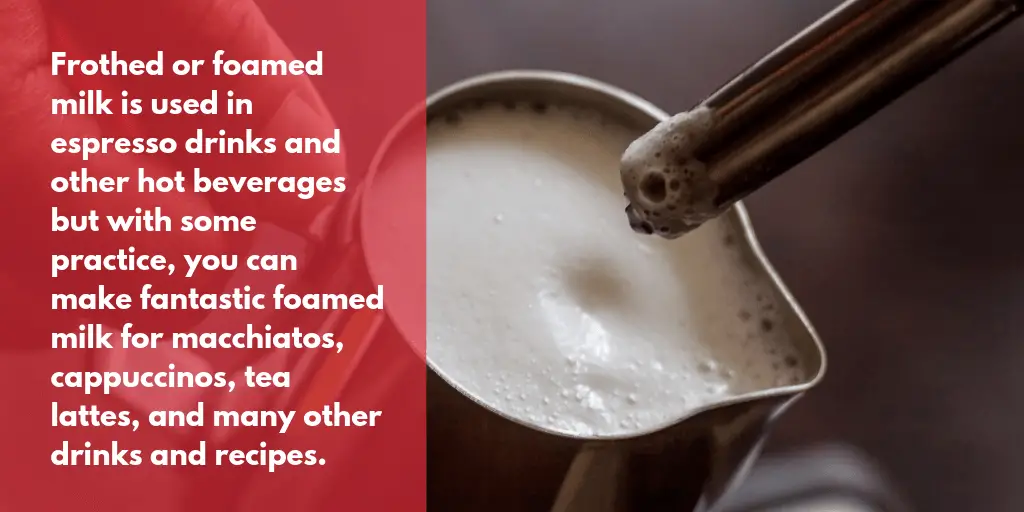
Finally, this may sound weird, but simply steaming your milk with an espresso machine offers perfect results! Depending on your needs, frothing the milk this way may produce the best results – but unfortunately, it only works if you have an espresso machine handy.
Espresso machine frothers work by introducing steam gradually to milk, and eventually, the natural fats within the beverage expand, creating the signature silky micro-foam.
Just delicious – and my kids love it!
I have this simple Steam Espresso System With Frother, it is very straightforward and cheap, but it works great and makes great frothed milk.
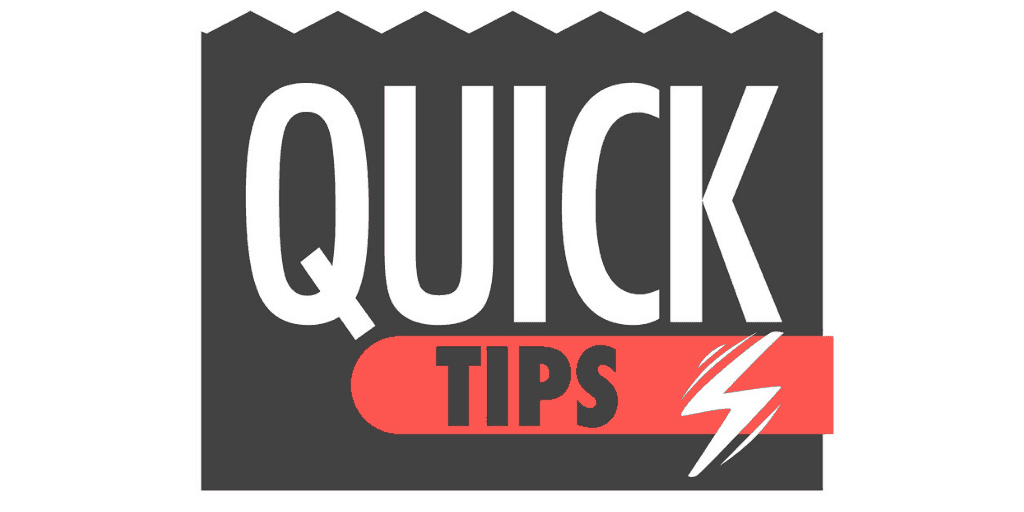
Boil Your Milk Like An Expert With Even More Tips And Tricks!
- If you’re in a rush, heat your milk in the microwave by pouring it into an appropriate container and heating it on 70% power, stirring every 15 seconds. Very soon, steam will start rising, which is when you know it’s ready.
- When using the double-boiler method, heat just until tiny bubbles start forming around the edge, and steam begins to rise.
- Raw milk requires boiling before consumption, pasteurized milk only needs to be boiled if it is stored at room temperature, and long-life milk is safe to drink right from the packet.
- Stainless steel heats up faster than cast iron, but you will need to pay closer attention to avoid running over and burning.
- Don’t forget to stir your milk occasionally when boiling – this helps to prevent coagulation.
- When the foam starts forming, break it up so it doesn’t trap the steam and cause overflowing.
- If safe to do so, leave the utensil in the pot during boiling to effortlessly break up the cream surface.
- Don’t overboil – anywhere over 2-3 minutes destroys beneficial nutrients in the milk.
- When microwaving milk, you can leave a wooden utensil in for easy stirring and break the foam.
Got a burnt layer of milk on the bottom of the pot, don’t throw it away, there’s a fix. Put a bit of water and vinegar in the pot and bring it to boil, remove the pot from heat, add baking soda, let it fizz, burnt milk lifts off. Wash the pot as usual.
Read Also: 11 Tips To Keep Milk Cool And Safe In A Hot Car
Conclusion
Hopefully, by now, you feel like a true milk-boiling expert! With a bit of practice and the right non-toxic cookware, you will see yourself getting perfect results in no time.






I’ve never heard of needing to boil milk for potatoes. I usually just add the milk in cold to hot potatoes, it warms right up. The only thing I really ever need to boil milk for is hot chocolate in the winter, and if I need it hot I just microwave it in my pyrex measuring cup. That usually does the trick!
Custard is another one I suppose, but that only happens on special occasions. Did you know that you can make quiche (which is basically just a custard) by adding sour cream to the eggs instead of having to go to all the trouble of heating milk and then making sure the eggs don’t cook as you whisk it in? That’s saved me tons of headache. It tastes just the same, too! Might not work for a sweet custard, but for quiche Lorraine it worked just fine!
Hi,
Regarding this part;
“To maintain the non-toxic properties, stainless steel cookware must never be cleaned with abrasive materials. Otherwise, the damaged lining may leach metals, which is why any damaged stainless-steel cookware item must be discarded immediately.”
I’m confused, what lining? Please elaborate on that.
Thanks.
Hi Emily.
I am sorry, I should have been a bit more clear about that as I was talking about Nickel lining that is quite often used to line stainless steel pans and pots. Many manufacturers use nickel and add it to stainless steel cookware to prevents corrosion and also make the pots last longer. But the problem is that Nickel is quite toxic metals. In most cases, the small amount of Nickel that is used to line stainless steel pots do not leach into your food and don’t cause any harm if you take care of the cookware properly.
What I meant was that cookware that is lined with Nickel should not be cleaned using heavy-duty cleaning pads or abrasive chemicals. This could damage and scratch Nickel lining on the pot and cause some of the metal to get into your food.